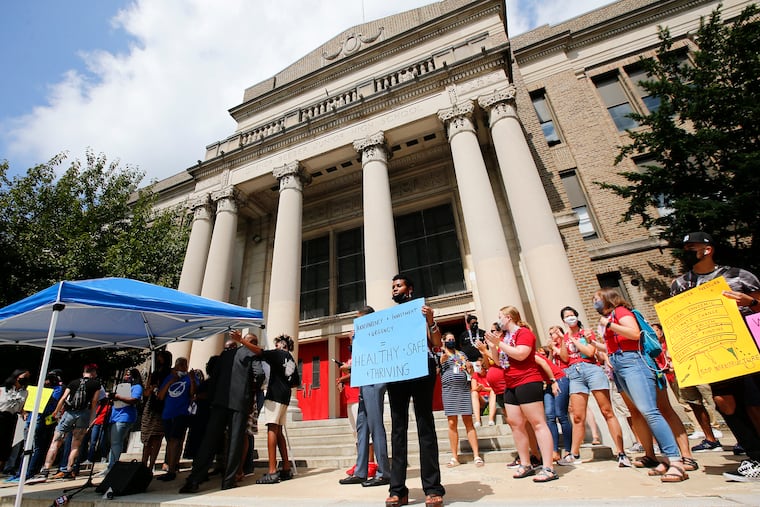SLA Beeber will learn virtually Tuesday, Philly’s first day of school, over building concerns
“We could have avoided this big calamity," Councilmember Kendra Brooks said.

Students at Science Leadership Academy at Beeber will learn virtually Tuesday and for the rest of the week, Philadelphia School District officials said, acknowledging community concerns over building conditions.
Teachers and the community were informed of the shift less than 24 hours before students were to report to their classrooms, most for the first time in 18 months. The emergency order came in response to an ongoing construction project at SLA Beeber that has left the school with exposed damaged asbestos, thick layers of dust, and a lack of adequate indoor bathrooms for the 700-plus student body. (The district had brought in outdoor portable toilets for students.)
“We’re going to try to be responsive to the SLA Beeber community,” Superintendent William R. Hite Jr. said Monday. District staff met with SLA Beeber representatives over the weekend to discuss their concerns.
All SLA Beeber students will learn virtually through Friday, then Sept. 8 when school resumes after Labor Day, the lower school — the West Philadelphia magnet educates children in grades 5 through 12 — will move to the old Powel Elementary for the remainder of the school year. Students in grades 9 through 12 will learn in-person in the SLA Beeber building for the rest of the year, district officials said Monday night.
SLA Beeber parents, students, and elected officials held a lunchtime rally to highlight what they say was a cavalier attempt on the district’s part to shoehorn them into a building that was not ready for students and teachers, despite the district’s troubled history of facilities issues.
City Councilmember Kendra Brooks, the parent of an SLA Beeber senior, is irate over a lack of communication from district officials. She sits on Council’s education committee, which met last week, and she heard about the ongoing issues at her daughter’s school not through work or the district, but on social media.
“It’s unacceptable,” said Brooks, who spoke at the rally. “Not because I’m a councilmember, because I’m a parent. For us to be completely caught off guard about situations with all the schools that aren’t prepared to open, or are having problems, it’s not OK.”
Had the community been looped in earlier, Brooks said, “we could have avoided this big calamity. We’ve had all this time, and we’ve been talking about all this mass investment.”
The SLA Beeber news came amid a growing unease around facilities issues, with organizers raising concerns that many schools around the city are in the same boat.
“Every student, teacher and staff member in the School District of Philadelphia deserves a safe and nurturing physical environment,” the West Philly Coalition for Neighborhood Schools said in a statement. “The current state of affairs is simply not sustainable.”
Masterman parents and public officials held a rally Monday to underscore their worries about asbestos. District officials said they’ve produced thousands of pages of documents about the school’s asbestos, but parents say they’ve had to file federal Freedom of Information Act requests for it, and don’t trust the district’s assurances about what work has been done.
“No family should have to file a legal document to get information about their school,” parent Emily Chaudhury said at the rally.
Some Masterman staff refused to go into the building Thursday and Friday, working outside to bring attention to the problems at the school. Staff who remained outside were marked absent without leave, forfeiting pay for the day. (Teachers worked inside the building Monday.)
City Councilmember Jamie Gauthier, a public school parent, told those gathered at Masterman that no one should be disciplined for asking for information.
“I stand with people all over the city who are demanding that our students have the safe buildings they deserve,” Gauthier said.
Hite, an in interview Monday, said discipline would be handled on “a case-by-case basis,” but “individuals need be at their workspaces when they’re supposed to be there.”
“That’s what we’re paying them for,” he said.
The superintendent said communities’ “concerns are real,” but “as our team shares more information and have an opportunity to dialogue, we hope people will be more comfortable.”
In a massive district — 120,000 students spread over 200-plus mostly old buildings — environmental concerns are a given. The district doesn’t have the money or the capacity to remove all asbestos, Hite said. Undamaged asbestos is harmless. But when disturbed, its tiny fibers pose potentially serious health risks.
“It has never been the removal of all [asbestos] from buildings,” Hite said. “I do think that’s creating some confusion.”
But, the superintendent said, “I am convinced that we’ve removed all of the imminent hazards that exist at Masterman.”
Parents and elected officials have questioned why the construction work at Masterman and SLA Beeber was not completed over the summer, or during the many months before when children were out of the buildings.
Hite said that wasn’t possible.
“We have too many buildings that need too much work to say that we can only work in them over the summer,” the superintendent said.
It’s an issue that’s not going anywhere. Over the next six years, the district has about $2 billion in federal money and borrowed funds to spend on capital projects.